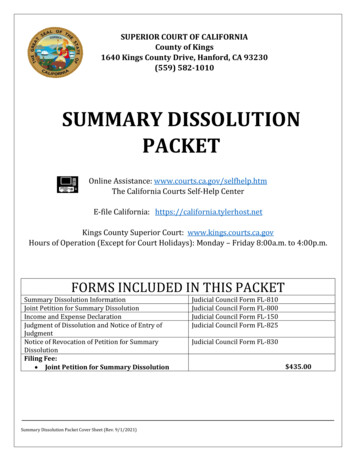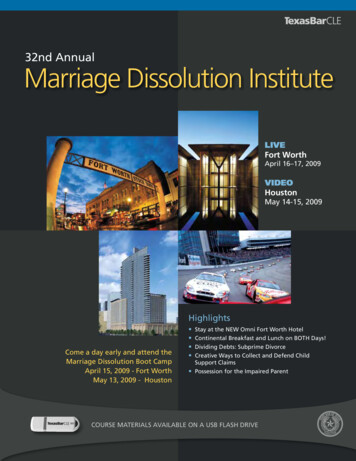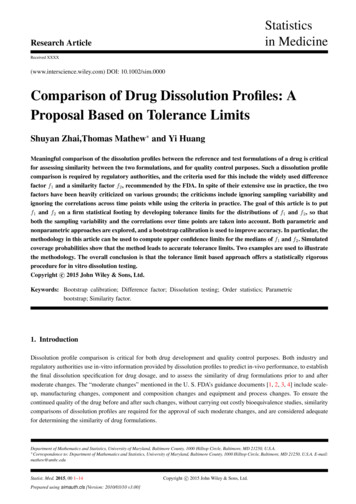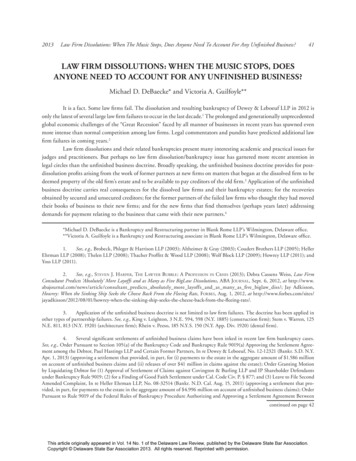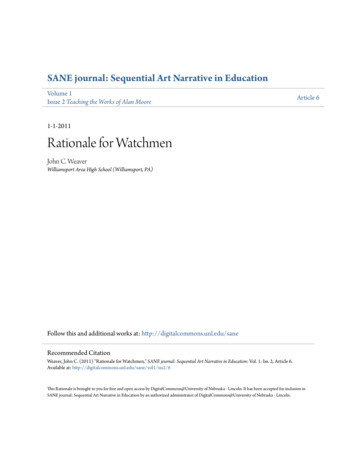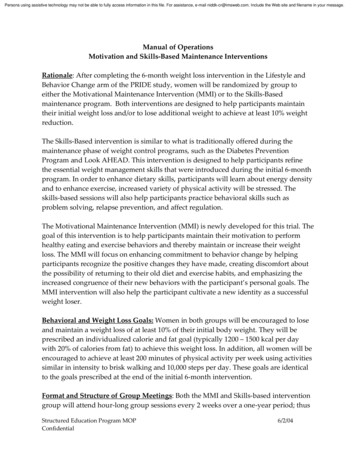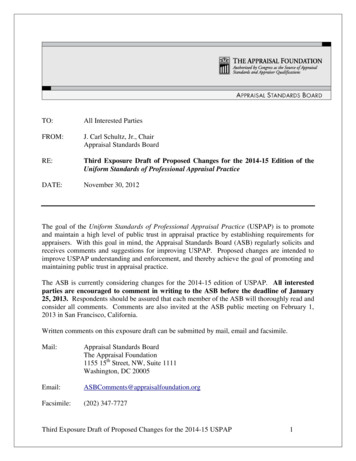
Transcription
dx.doi.org/10.14227/DT200313P6Rationale for Selection of DissolutionMedia: Three Case StudiesNikoletta Fotaki1, William Brown2, Jianmei Kochling3,Hitesh Chokshi4, Hai Miao5, Kin Tang4, and Vivian Gray7,*e-mail: vagray@rcn.com1Universityof Bath, Bath, UKStates Pharmacopeial Convention, Rockville, MD, USA3Genzyme, Waltham, MA, USA4Roche, Nutley, NJ, USA5Vertex Pharmaceuticals, Cambridge, MA, USA6V. A. Gray Consulting, Inc., 9 Yorkridge Trail, Hockessin, DE, 19707, USA2UnitedABSTRACTThe selection of media in dissolution method development can sometimes be an arbitrary decision. The case studies in thisarticle give a practical rationale that should help in selecting media, especially surfactants.Three cases were studied: (1) the role of surfactants versus compound stability in the dissolution medium during dissolution method development, (2) the selection of a surfactant based on interactions between the dissolution medium and thedrug substance, and (3) the selection of media based on formulation properties.In the first case study, the choice of surfactant in relation to solubility and physical stability of the drug substance is shown.The second revealed an unexpected synergy between polysorbate 20 (Tween) and acetic acid solution that caused anunusual increase in the dissolution rate compared with these media used separately. In the last case study, the medium wasmodified by addition of surfactant to reflect a change in the formulation.The selection of a dissolution medium should be based on drug substance and formulation characteristics as well as oninteractions among components.INTRODUCTIONhe media typically used in dissolution studiesinclude acidic solutions, buffers, surfactants, andsurfactants with acid or buffers (1). Media with bilesalts and other relevant physiologically based ingredients,sometimes called biorelevant media, can be used in regulatory tests, but typically are used as research tools or forin vitro–in vivo correlation studies (2).Surfactants are used in dissolution test methods toimprove the solubility or wettability of a drug. Sometimesthe decision to use a surfactant is based solely on thefact that it will facilitate drug dissolution and not on anyfurther study. It is thus important to understand scientifically the interaction mechanisms between different typesof surfactants and drug molecules as well as interactionswith excipients. This understanding should guide the analyst in selecting the most appropriate media for methodsthat will be used in formulation development and drugproduct dissolution testing.Surfactants reduce solution and surface interfacialtension by replacing water molecules on the surface (3).Surfactant molecules include two distinct components,the head (hydrophilic area) and the tail (hydrophobicarea). Surfactants can be classified as anionic (e.g., sodium lauryl sulfate [SLS], also known as sodium dodecylsulfate [SDS]), cationic (e.g., cetyl trimethyl ammoniumbromide [CTAB]), zwitterionic (e.g., alkyl betaine), orT*Corresponding author.6Dissolution Technologies AUGUST 2013nonionic (e.g., Tween or Cremophor EL) (4), as shown inFigure 1.Surfactants exist as monomers at low concentration insolutions. Aggregation occurs with increasing concentration and results in the formation of micelles. The minimumconcentration of a monomer at which micelles form iscalled critical micelle concentration (CMC). The stability ofmicelles is related to their CMC value: the lower the CMCvalue of a given surfactant, the more stable the micelles(5) (Table 1). In dissolution testing, the micelle of surfactant molecules mimics the bile acid aggregates in thesmall intestine; the surfactant facilitates the diffusion andtransport of the free solute into the bulk medium. Sincedissolution is a combined effect of solubility and diffusivity, the micelle size will have an effect on the dissolutionrate of molecules when different surfactants are used.Micellar-driven drug solubilization occurs with an increasein the number of micelles when the surfactant concentration is higher than the CMC value (6). In fact, solubilityenhancement is a function of surfactant concentration.This relationship generally can be found for different surfactants and different compounds (3, 7, 8).Micellar drug solubilization is affected by many factors:the nature of the surfactant and the drug substance (e.g.,nonpolar molecules are solubilized in the micellar core,whereas those with intermediate polarity are distributedalong the surfactant molecules in certain intermediatepositions), temperature, pH, and ionic strength (3, 6). Forionic surfactants, the CMC values decrease and the micel-
Table 1. CMC Values (mM) of Commonly Used Surfactants inWater at 25 CFigure 1. Structures of commonly used surfactants in dissolution: SLS(anionic), CTAB (cationic), and Tween 80 (nonionic).lar size increases upon addition of an electrolyte to thesolution. The type of surfactant determines the effect ofionic strength; for example, the solubility of mefenamicacid is affected by a change in ionic strength when SLS isused but not when CTAB is used (9). In addition, the purityof the surfactant must be considered because it can extensively affect the size and loading capacity of a micelle,which results in changes in solubility and dissolution rate(10, 11). Moreover, interactions among the ions and thetype of surfactant used must also be considered carefully when dissolution media are selected. For example,potassium ions can interact with SLS, forming an insolubleproduct (12).For acidic drugs, media containing cationic surfactantsare better able to discriminate dissolution rate than mediacontaining other types of surfactants (9).An important point about the use of surfactants indissolution media is that they have different effects onFigure 2. Solubility–dissolution enhancement of griseofulvin by ionic (SLS,CTAB) and nonionic (Tween 80) surfactants. (Data adapted and modifiedfrom ref 3.)SurfactantTypeCMC (mM)Triton X-100Nonionic0.24Tween 20Nonionic0.06Tween 40Nonionic0.027Tween 80Nonionic0.012CTABCationic1SLSAnionic7–10the dissolution rate and solubility of the drug substance. For example, the dissolution rate of ibuprofenfrom tablets in HCl solutions with different surfactants(cationic, anionic, and nonionic) is not affected by thesurfactants, even though the solubility of ibuprofen wassignificantly different in these solutions (9). Another example is griseofulvin, for which addition of several concentrations of ionic (SLS, CTAB) and nonionic (Tween80) surfactants resulted in a greater enhancement ofdrug solubility relative to its dissolution (3). Interestingly, the enhancement of the solubility to dissolutionratio was almost constant in all cases except for thelow concentration of SLS and the high concentration ofCTAB (Figure 2).In dosage systems that contain polymer, the interactions between polymers and surfactants in aqueousmedia give rise to the formation of association structures,thereby modifying the solution and interfacial properties.The morphologies of association complexes depend onthe molecular properties of the polymer and the surfactant. The presence of a polymer lowers the CMC andreduces the size of spherical micelles (13, 14).The first case study examines the choice of surfactant(anionic, cationic, or neutral) in terms of the solubility andphysical stability of the drug substance. The second casestudy shows an unexpected synergy between polysorbate20 (Tween) and acetic acid solution that causes an unusualincrease in the dissolution rate relative to the media usedFigure 3. Solubility of Compound A in different concentrations of surfactants.Dissolution Technologies AUGUST 20137
Figure 6. Stability of Compound A salt in (A) SLS and (B) Tween 80 solutions.Figure 4. Stability of Compound A spray-dried dispersion (SDD) in anionicsurfactant (SLS).Figure 5. Stability of Compound A spray-dried dispersion (SDD) in nonionicsurfactant (Tween 80).separately. In the last case study, the medium was modified by addition of surfactant to reflect a change in theformulation.CASE STUDIESCase Study 1: Effect of Different Surfactants (Anionic,Cationic, and Nonionic) on Solubility and PhysicalStabilityThe CMCs for SLS and Tween 80 are approximately0.24% and 0.012% w/w, respectively. A linear relationshipexists between the surfactant (SLS or Tween 80) concentration and the equilibrium solubility of the studiedcompound, Compound A (Figure 3). In addition, the compound’s solubility in SLS is much higher than in Tween 80.The lower solubility in Tween 80 may be largely related tothe large molecular weight of Tween 80 and the limitednumber of molecules that can be incorporated intothe Tween 80 micelles (3). In addition, the diffusivity ofTween 80 micelles is much slower than that of SLS, whichnecessitates a higher Tween 80 concentration to achievedissolution profiles that are similar to those obtained withSLS. Additionally, the preparation of a high concentrationof Tween 80 dissolution medium can be a challenge. Withan increase in the concentration of viscous Tween 80,solution foaming increases, which leads to large variationsin analytical results.8Dissolution Technologies AUGUST 2013Figure 7. Solubility and stability of Compound A salt in CTAB.Although surfactants can increase the solubility ofpoorly soluble compounds, different surfactants alsocan affect the physical stability of the study systemsby maintaining the solubility of the compound in thesurfactant medium without precipitation, for example.This is a common concern especially when the compoundis not in the most stable polymorphic form. The roles ofsurfactants in compound solubility have been evaluated(3, 8). However, very little research has focused on the roleof surfactants in the physical stability of compounds. Infact, understanding the physical stability of compounds indifferent surfactants is not only important for dissolutionmethod development but is also critical for formulationdevelopment, especially liquid dosage forms. Increasedunderstanding of surfactants and physical stability mayshed light on formulation physical behavior in vivo.The freebase of Compound A is a stable crystalline, neutral molecule (pKa 7) that has a solubility value of about0.2–0.4 µg/mL in aqueous solution in the pH range of3–7. The amorphous form was prepared by spray-dryingthe freebase with hypromellose acetate succinate (HPMCAS). Although changing to the amorphous spray-drieddispersion did not improve the aqueous solubility noticeably, it improved the bioavailability of the compound. Asurfactant was needed to maintain sufficient solubility ofthe compound in 900 mL of dissolution medium. Severaldifferent surfactants—anionic (SLS), cationic, and neutral
Figure 9. Chemical structure of triamterene.Figure 8. Example of drug–polymer solid dispersion.(Tween 80)—were screened and differences in the physical stability of amorphous Compound A are presented inthis case study.As shown in Figure 4, amorphous Compound A is stablein SLS with no change of solubility over 44 h in the pHrange of 2.0–6.8. The solubility of the solid dispersion wasmaintained at 0.6 mg/mL in 0.6% SLS, which was greaterthan the solubility in its freebase crystalline form.Amorphous Compound A was added to the nonionicsurfactant Tween 80 solutions in the same pH range of2.0–6.8. The initial solubility was 0.2 mg/mL in 0.07%Tween 80 solution; however, solubility decreased withtime, probably due to formation of crystalline forms. Asshown in Figure 5, the stability of amorphous CompoundA in Tween 80 also depends on pH, and stability followsthe trend of pH 1.2 4.5 6.8.The besylate salt form of Compound A also demonstrated slightly better stability in SLS solution than inTween 80 solution. The solution was stable for 3.5 h in SLSversus 1 hour stability in Tween 80, as shown in Figure 6.In addition to noting solubility changes as an exhibitionof physical stability, physical form change was detectedusing X-ray powder diffraction (XRPD) (data not shown).The original polymorph was detected in a precipitate onlyat the 1-h time point in SLS solution and not at later timepoints (4 h and 22 h) in Tween 80. Compound A salt dissolved in a cationic surfactant (CTAB) had stability similarto that in SLS solution (Figure 7) and was physically stableonly for 1 h. Other forms were detected by XRPD at 4 and22 h.DiscussionIn the past few years, spray-dried solid dispersion (SDD)processing has gained popularity in the pharmaceuticalindustry (15). This procedure is used to enhance the bioavailability of poorly soluble drugs by converting a stablecrystalline form, which has low solubility, to a metastableamorphous form that has higher solubility. However, evenwith form conversion, solubility enhancers such as surfactants are still needed, sometimes in both the formulationand the dissolution media.Figure 8 illustrates a drug–polymer solid dispersion inwhich the polymer serves as a carrier and the drug molecule is dissolved in the polymer matrix (16). The dryingprocess uses a volatile solvent in which both polymer anddrug molecules dissolve and generate an amorphous formof the drug molecule. The copresence of polymer anddrug molecule in the solid mixture not only increases drugsolubility but also the stability of the amorphous drug. Theincreased solubility is caused by easier accessibility for thewater molecules, and the greater wettability of the drugmolecules is caused by the use of a water-soluble polymerand sometimes a surfactant. The increased stability of theSDD system may be due to extra energy (and thus moretime) needed for the drug molecules to separate fromthe polymer matrix. Some spray-dried dispersions can bestable for years at room temperature (17, 18), althoughmanufacturers should take care to treat such systems asamorphous by protecting them from moisture.The dissolution medium has a large influence on thesolubility and stability of amorphous drug substancemolecules. Using the HPMCAS solid dispersion compoundas an example, we see that the stability of the solid dispersion system in solution depends largely on the pH and thesurfactant type (19) (Figures 4 and 5).As shown in Figure 4, Compound A was stable in theSLS solution for more than 40 h but was not stable inthe polysorbate 80 solution (Figure 5). The stability ofCompound A in the SLS solution may be related to theinteraction between the polymer and the surfactantmicelle hydrophobic chain (20, 21). This solid dispersionalso interacted with the Tween 80 polymer chain due tothe small number of drug molecules that can be incorporated into the Tween 80 micelles and low diffusivity of themicelles (3). However, the lower solubility of CompoundA solid dispersion in Tween 80 may offer a greater chancefor Compound A to be in a free form in solution. Once insolution, the polymer and Compound A separated, whichresulted in the conversion of the amorphous form to itsstable crystalline freebase form. A comparison of Figures4 and 5 shows that the conversion rate of the amorphousto the crystalline form was so low that it was not observedwithin 44 h in SLS, but the conversion was almost immediate in the Tween 80 solution (Figure 5).Dissolution Technologies AUGUST 20139
Figure 11. pH–solubility profile of compound B.Figure 10. Dissolution results at 2 h for triamterene in various media(% label claim).Interestingly, the Compound A salt form had similar stability in both anionic and cationic surfactant solutions, asshown in Figures 6A and 7. The stability of the compound/surfactant solution systems was probably dictated by thesimilar micelle size and the number of drug molecules thatwere incorporated into the SLS and CTAB micelles ratherthan by the surfactant charge state. The results are consistent with observations reported by Balakrishnan et al. (3).Case Study ConclusionsAs for choosing a surfactant for the dissolution method,there are a few scenarios. If the surfactant is used toincrease the solubility of the compound and there is noconcern about physical stability, decisions can be basedsimply on the enhancement of solubility, and both ionicand nonionic can be considered. However, if there is aphysical stability issue, the type of surfactant that allowsslower rate of conversion due to micelle size and thenumber of drug molecules that can be incorporated intothe micelles (e.g., SLS and CTAB) may have an advantage.A final and important consideration is chemical stability.Although any degradation 1% is not a major concern,degradation of API in the surfactant solution should alsobe considered during dissolution method development.Case Study 2: Synergistic Effect of Surfactant andAcetic Acid SolutionAn improved dissolution method for an immediaterelease (IR) combination capsule product of hydrochlorothiazide and triamterene (pKa 6.2; Figure 9) wasdeveloped (22). The dissolution performance of the lesssoluble component, triamterene, in a series of media wasevaluated (Figure 10). A five-fold increase in triamterenepercent dissolved was observed in the selected medium(0.1 M acetic acid with 1% w/v Tween 20) relative to thepercent dissolved in each medium used separately (0.1M acetic acid or 1% (w/v) with Tween 20). The dissolution10Dissolution Technologies AUGUST 2013conditions were USP Apparatus 1, rotating basket, 100rpm, and 900 mL of medium at 37 C.DiscussionThe 0.1 N HCl medium resulted in 20% triamterenedissolved from the product in 2 h (Figure 10). At 2 h, thepercent dissolved was 1% in both 0.5% SLS and 0.5%SLS adjusted to pH 4.5 with acetate buffer (0.02 M sodiumacetate and 0.03 M acetic acid).Complete dissolution was observed in the medium 0.1M acetic acid with 1% Tween 20 (Figure 10). The increasedtriamterene dissolution rate apparently was a product ofsynergetic interaction between the Tween 20 and aceticacid. The pH value of this medium was 3.2. The increasedtriamterene dissolution is not attributable to medium pH,Tween 20 concentration, or the simple combination of pHwith Tween 20 concentration. A 5- to 6-fold increase indissolution was obtained over 1% Tween 20, 0.1 M aceticacid, and 0.001 N HCl with 1% Tween 20. There was anincremental increase in the dissolution rate with increasing concentration of acetic acid from 0.05 M to 0.1 M with1% Tween 20.The effect of the presence of surfactant on the dissolution rate in this case was observed only with the nonionicsurfactant (Tween 20) and not with the anionic one (SLS).On the one hand, triamterene is weak base, and hencesolubility should increase with a decrease in pH. On theother hand, SLS has a higher ionization with an increase inpH (pKa 1.9), which should result in a favorable situationfor solubility enhancement. The anions of SLS may interactwith the cationic drug species to form an insoluble saltand result in desolubilization; this phenomenon has beenreported (8, 23). The better solubilization obtained withthe nonionic surfactant could be because nonionic surfactants provide high micellar concentration and good molarsolubilization capacity due to the low CMC value (8).Case Study ConclusionsThe interaction of acetic acid with Tween 20 producedan increase in the dissolution rate of the limiting com-
ponent, triamterene, that was not attributable to thesurfactant concentration or the pH acting alone. Nor wasthe concentration of acetic acid solely attributable as afactor. Apparently, the presence of acetic acid enhancesthe dissolution rate of triamterene in Tween 20 medium.This example suggests that surfactant must be chosencarefully when pH also has an effect on API solubility.Case Study 3: Selection of Dissolution Medium Basedon Formulation ChangeA successful dissolution method was developed foran IR formulation of a dibasic compound (Compound B).The dissolution conditions were USP Apparatus 2 (rotating paddle), 100 rpm, and 900 mL of 0.003 N HCl (pH 2.5)at 37 C. A change in the formulation necessitated thechange of the dissolution method to a medium of pH 6.8with the addition of surfactant (SLS).DiscussionCompound B is a high molecular weight dibasic compound (pKa1 3.93, pKa2 5.42). The freebase was used inthe development of an IR tablet to be taken once or twicea day. The compound is highly soluble in acidic aqueousmedia and is sparingly soluble in aqueous media at a pHgreater than 4, as shown in the pH–solubility profile inFigure 11. Based on the high solubility observed at acidicpH, a dissolution test was developed using USP Apparatus2 (paddles) operated at 75 rpm with 900 mL of 0.003 N HCl(pH 2.5). The amount of drug dissolved, determined byUV, is shown in Figure 12 for three 250-mg tablet formulations. Tablet A and Tablet B are of the same prototypecomposition and differ only in the particle size of the drugsubstance used to prepare the tablet (A: D50 217 µm;B: D50 4.6 µm). The composition of Tablet C (D50 7.3µm), which differs slightly from that of Tablets A and B,contains a higher drug load to obtain a smaller tablet forpatient compliance. As shown in Figure 12, differencesin dissolution rate due to the pronounced differences indrug substance particle size can be seen in the acidic media. Therefore, particle size reduction is desired to obtaina rapidly dissolving product in acidic media. It is not clearif the differences in dissolution rate between Tablet B andTablet C are attributable to particle size, as there are alsoformulation differences. The higher drug load of a weaklybasic compound that exhibits high solubility at acidic pHmay drive the slightly faster dissolution rate observed withTablet C.An in vivo study in dogs revealed differences consistentwith those observed in the in vitro study (Figure 13), supporting the selection of the dissolution method.A second-generation formulation containing the drugand an anionic polymer in the tablet matrix was developed. Because the anionic polymer is insoluble in acidicsolution, the original dissolution method was not suitable.Figure 14A shows the dissolution profiles for the original250-mg IR tablet (Formulation I) and a 50-mg IR tabletFigure 12. Dissolution profile of compound B, 250-mg film-coated IRtablets. Tablet A: Prototype #1 tablet made with unmilled drug substance(D50 217 µm); Tablet B: Prototype #1 tablet made with micronized drugsubstance (D50 4.6 µm); Tablet C: Prototype #2 tablet made with micronized drug substance (D50 7.3 µm). Testing performed with USP Apparatus2, 75 rpm, 900 mL of 0.003 N HCl; detection by UV.Figure 13. Plasma concentration profile of compound B dosed to dogs as250-mg film-coated IR tablets. Tablet A: Prototype #1 tablet made withunmilled drug substance (D50 217 µm); Tablet B: Prototype #1 tabletmade with micronized drug substance (D50 4.6 µm); Tablet C: Prototype#2 tablet made with micronized drug substance (D50 7.3 µm).containing the anionic polymer (Formulation II). In acidicmedium, Formulation I exhibits a rapid dissolution profile,whereas Formulation II exhibits a considerably slowerprofile. To address the pH-dependent solubility of theanionic polymer in Formulation II, the pH of the mediumwas raised to 6.8 where the anionic polymer will dissolve.A small amount of SLS (0.25%) was added to the newmedium to solubilize the weak base drug in FormulationII. Figure 14B shows the dissolution profiles for the sametwo tablet formulations. Both Formulation I and Formulation II exhibit dissolution profiles that are consistent withan IR tablet product. The slightly lower rate and extent ofdissolution observed in Formulation I are attributed to theDissolution Technologies AUGUST 201311
provides instructions on ways to choose media that areconsistent with a good understanding of the producttested. In summary, product solubility, product stability,synergistic effects of particular agents, and changes in theformulation and formulation excipients are essential factors to consider in the selection of an appropriate dissolution medium.Figure 14. Dissolution profiles obtained in (A) 0.01 N HCl and (B) 0.25%sodium lauryl sulfate/ pH 6.8 phosphate buffer for Tablet Formulation I (IRtablet made with conventional excipients) and Tablet Formulation II (IRtablet containing anionic polymer). Testing performed with USP Apparatus2, 75 rpm, 900 mL medium; detection by UV.higher dosage strength, 250 mg, versus 50 mg for Formulation II.Case Study ConclusionsIn this example, an acidic medium was used for thedissolution method of a weak base. A formulation changewith the inclusion of an anionic polymer in the matrixnecessitated the change to a more alkaline dissolutionmedium, and thus a surfactant was selected to enablesolubilization of the API. This study demonstrates the roleof formulation excipients in dissolution method development. Decisions on dissolution method developmentmust be based not only on API properties but also onformulation properties. The dissolution method may needto be changed substantially due to formulation excipientproperties.CONCLUSIONSThe case studies described in this paper present arationale for the selection of dissolution media. Each case12Dissolution Technologies AUGUST 2013REFERENCES1. The United States Pharmacopeia and National FormularyUSP 32–NF 27; The United States PharmacopeialConvention, Inc.: Rockville, MD, 2009.2. Fotaki, N.; Vertzoni, M. Biorelevant Dissolution Methodsand Their Applications in In Vitro-In Vivo Correlationsfor Oral Formulations. The Open Drug Deliv. J. 2010, 4,2–13.3. Balakrishnan, A.; Rege, B. D.; Amidon, G. L.; Polli, J. E.Surfactant-mediated dissolution: contributions of solubility enhancement and relatively low micelle diffusivity. J. Pharm. Sci. 2004, 93 (8), 2064–2075.4. Fathi Azarbayjani, A.; Jouyban, A.; Chan, S. Y. Impact ofsurface tension in pharmaceutical sciences. J. Pharm.Pharm. Sci. 2009, 12 (2), 218–228.5. Florence, A. T.; Attwood, D. Surfactants. InPhysicochemical Principles of Pharmacy, 4th ed.;Pharmaceutical Press: London, 2006; pp 177–228.6. Rangel-Yagui, C. O.; Pessoa, A. Jr.; Tavares, L. C. Micellarsolubilization of drugs. J. Pharm. Pharm. Sci. 2005, 8 (2),147–163.7. Morozowich, W.; Gao, P.; Charton, M. Speeding thedevelopment of poorly soluble/poorly permeabledrugs by SEDDS/S-SEDDS formulations and prodrugs.Part 1. Am. Pharm. Rev. 2006, 9, 110–114.8. Chakraborty, S.; Shukla, D.; Jain, A.; Mishra, B.; Singh, S.Assessment of solubilization characteristics of differentsurfactants for carvedilol phosphate as a function ofpH. J. Colloid Interface Sci. 2009, 335 (2), 242–249.9. Park, S. H.; Choi, H. K. The effects of surfactants onthe dissolution profiles of poorly water-soluble acidicdrugs. Int. J. Pharm. 2006, 321 (1–2), 35–41.10. Crison, J. R.; Shah, V. P.; Skelly, J. P.; Amidon, G. L. Drugdissolution into micellar solutions: development ofa convective diffusion model and comparison to thefilm equilibrium model with application to surfactantfacilitated dissolution of carbamazepine. J. Pharm. Sci.1996, 85 (9), 1005–1011.11. Qiang, D.; Gunn, J. A.; Schultz, L.; Li, Z. J. Evaluation ofthe impact of sodium lauryl sulfate source variabilityon solid oral dosage form development. Drug Dev. Ind.Pharm. 2010, 36 (12), 1486–1496.12. Ropers, M. H.; Czichocki, G.; Brezesinski, G. Counterioneffect on the thermodynamics of micellization of alkylsulfates. J. Phys. Chem. B 2003, 107 (22), 5281–5288.13. Benrraou, M.; Bales, B.; Zana, R. Effect of the natureof the counterion on the interaction between cesium and tetraalkylammonium dodecylsulfates and
14.15.16.17.18.19.poly(ethylene oxide) or poly(vinylpyrolidone). J. ColloidInterface Sci. 2003, 267 (2), 519–523.Nagarajan, R. Polymer–Surfactant Interactions. InDetergents for the New Millennium, Proceeding of NewHorizons Conference, American Oil Chemists Societyand Consumer Specialty Products Association, FortMyers, FL, Oct 14–17, 2001.Bikiaris, D. N. Solid dispersions, part I: recent evolutionsand future opportunities in manufacturing methodsfor dissolution rate enhancement of poorly watersoluble drugs. Expert Opin. Drug Delivery 2011, 8 (11),1501–1519.Tang, L.; Khan, S. U.; Muhammad, N. A. Evaluationand selection of bio-relevant dissolution media for apoorly water-soluble new chemical entity. Pharm. Dev.Technol. 2001, 6 (4), 531–540.Shah, V. P.; Konecny, J. J.; Everett, R. L.; McCullough, B.;Noorizadeh, A. C.; Skelly, J. P. In vitro dissolution profileof water-insoluble drug dosage forms in the presenceof surfactants. Pharm. Res. 1989, 6 (7), 612–618.Friesen, D. T.; Shanker, R.; Crew, M.; Smithey, D. T.;Curatolo, W. J.; Nightingale, J. A. Hydroxypropyl methylcellulose acetate succinate-based spray-dried dispersions: an overview. Mol. Pharm. 2008, 5 (6), 1003–1019.Curatolo, W.; Nightingale, J. A.; Herbig, S. M. Utilityof hydroxypropylmethylcellulose acetate succinate(HPMCAS) for initiation and maintenance of drug20.21.22.23.24.25.supersaturation in the GI milieu. Pharm. Res. 2009, 26(6), 1419–1431.Bai, G.; Catita, J. A. M.; Nichifor, M.; Bastos, M.Microcalorimetric evidence of hydrophobic interactions between hydrophobically modified cationic polysaccharides and surfactants of the same charge. J. Phys.Chem. B 2007, 111 (39), 11453–11462.de Martins, R. M.; Silva, C. A.; Becker, C.; Samios, D.;Bica, C. I. D.; Christoff, M. Studies on Anionic SurfactantStructure in the Aggregation with (Hydroxypropyl)cellulose. Polimeros 2002, 12 (2), 109–114.Albert, A. Selective Toxicity, 4th ed.; Methuen: London,1968.Jain, A.; Ran, Y.; Yalkowsky, S. Effect of pH–sodiumlauryl sulfate combination on solubilization ofPG-300995 (an anti-HIV agent): a technical note. AAPSPharmSciTech 2004, 5 (3), 65–67.Sigma-Aldrich: Detergents Properties and s/15402/Detergent Selection Table.pdf (accessed June 19,2013).Hait, S. K.; Moulik, S. P. Determination of critical micelleconcentration (CMC) of nonionic surfactants by donoracceptor interaction with iodine and correlation ofCMC with hydrophile–lipophile balance and oth
Three cases were studied: (1) the role of surfactants versus compound stability in the dissolution medium during dissolu-tion method development, (2) the selection of a surfactant based on interactions between the dissolution medium and the . dissolution is a combined effect of solubility and diffusiv-ity, the micelle size will have an effect .
